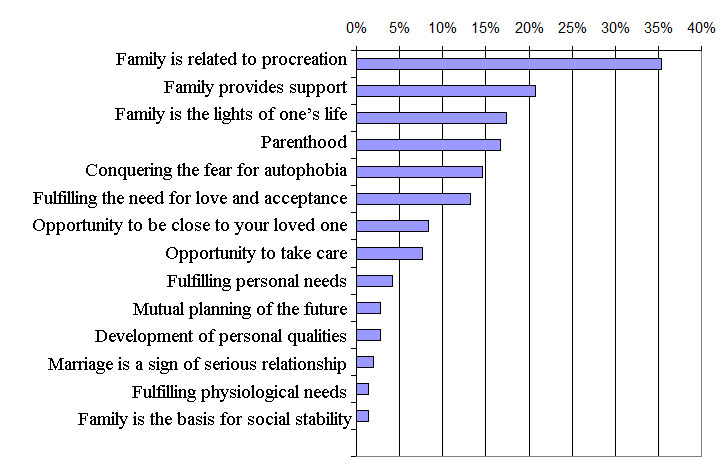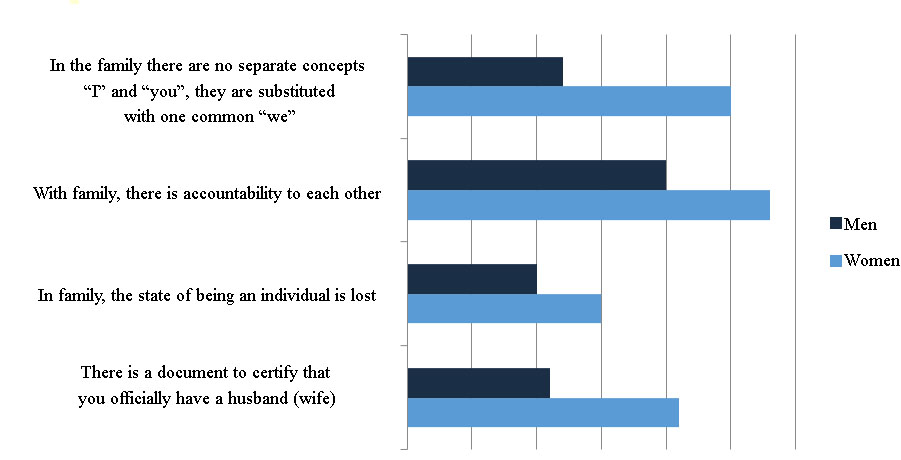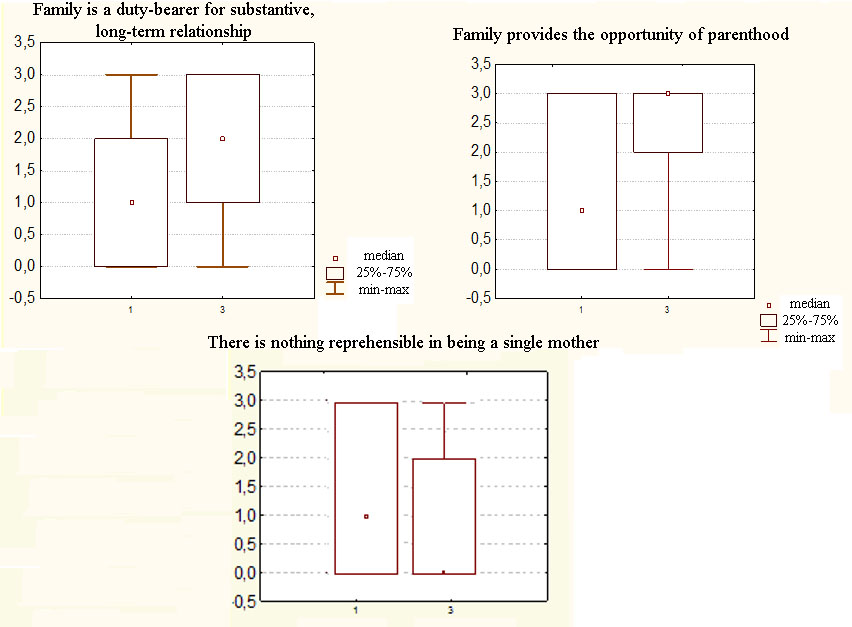Abstract
The paper is concerned with the analysis of the image of family as it is perceived by the modern young through a series of image-making factors. The relevance of the issue under study is due to the decline in family awareness amongst the youth, expressed in the rejection of marriage, the increase in the number of divorces and alternative forms of marriage. It assumes that the attitude towards marriage is conditioned by the image of the family. The empirical research attempts to reconstruct the image of the family and to articulate the key parameters for analysis. The important parameters for creating the image of family are identified to be the prospects that open up with the family, parenthood opportunities, responsibility and mutual obligations of spouses. Gender, age and ethno-cultural affiliation influence the formation of family image. In terms of gender, significant differences are determined in parameters of reliability of partnerships and the legal protection of family. Through the lens of age, differences are determined in the significance of social assessments and the status that the family provides for its members. Cross-cultural differences are manifested in the high importance of social assessments, and in the fact that the family is associated with the birth of children. It is established that the image of the family as perceived by the modern youth congruently reflects social functions and tasks of the family. The author suggests that the willingness of young people to assume commitment to the family is being transformed today.
Keywords: Image of familya conjugal paradigmfamily values
Introduction
The culture of society and its traditions are constantly evolving, so the subject of family as its main cell always retains its importance. In domestic science, the idea is widespread that as a result of socio-economic transformations taking place in modern society, the family institution is in crisis, the value of the family and family lifestyle in the perception of youth is declined. In this regard, particular importance is attached to the process of cultural transformations, during which traditional views of the family, its structure, ideas of gender and role models of a conjugal paradigm, distribution of functions and tasks, etc., are often destroyed. The overestimation of the value of the family is manifested to a greater extent in the consciousness of young adults. These disappointing conclusions are supported by Roskomstat data: the percentage of marriages per capita has decreased, the percentage of divorces has increased, the number of children in marriage has decreased, the cases of deliberate refusal to start a family and the birth of children have increased, and the share of non-conventional families has increased (Roskomstat, 2018).
The urgency of the family issue is attributed to the need to come up with new value orientations and basis of subsistence.
Problem Statement
In modern scientific literature there are many interpretations of the concept of family. Their content in a generalized form represents a family as a group of people related by consanguinity (by recognized birth, relations by blood) or affinity (by marriage), whose members lead a common life and have mutual moral obligations to each other.
Various aspects of family life have been addressed in the studies of a wide range of scientists. They studied the history of a family to be born as a social entity (Bachofen, 2018; Morgan & White, 1993; Sorokin, 1997; Zider, 1997; Druzhinin, 2008), its transformations in the context of socio-economic growth of society (Marx & Engels, 1998). They proposed the ontology of various functions of the family (Murdoch, 2003; Golod, 1998), depicted the place and role of the family in the socialization of a person as a member of society (Erickson, 2000; Mead, 1988; Cohn, 2003), considered the structure, types and forms of families through a cross-cultural approach (Bronfenbrenner, 1979; Antonov & Medkov, 2007), and reported the family within a transforming society (Artyukhov, 1998; Kartseva, 2003). These works formed the methodological basis for the present study.
Research Questions
The subject of the study is the reflective embodiment of family structure, its functions and tasks, the role in human life as perceived by the modern youth.
As a working hypothesis, it was suggested that such characteristics as gender, age, individual experience, personal maturity, ethnic culture, etc., influence the formation of the family image in the consciousness of an agent. The image of family formed under the influence of various social and psychological factors specifies conjugal attitudes of young people.
Purpose of the Study
The study towards the image of the family and the socio-psychological factors that play a crucial role in its formation was aimed at providing the rationale for the programs geared to train and adapt young people to marriage and family life.
Research Methods
The program of empirical research included two stages: the stage of qualitative and quantitative studies.
The first stage was aimed at reconstructing the image of the family in the views of young people and to establish the main parameters for its conveyance. This stage included focus groups, structured interviews, conversations, and self-report protocols, which were subsequently processed through the content analysis. This method enabled to distinguish the main categories by whose means the image of the family is represented in the minds of young people and to give their informative characteristics.
The objectives of the second stage were aimed at identifying the prevalence of certain ideas of the family in different social and ethnic groups of young people inhabiting the Crimea. At this stage, mass survey questionnaires designed to rely on qualitative data were used.
Findings
At the stage of qualitative study towards the image of the family, the following areas of analysis were identified: a normative family as it used to be in the past; a real family in culture as the way it looks like now; an ideal family, the most desired and expected characteristics of the family (orientation towards the future). Resulting from the content analysis of focus groups protocols, 14 categories describing the family were singled out. These categories were grouped into clusters of positive and negative traits of the family image.
The questionnaire designed in the light of the categories obtained was built on the principle of semantic differential. Each parameter represented a bipolar scale, with one of the poles to describe the positive features of the image of the family against this parameter, and the other – negative. For example, the parameter “The prospects ensured by the family for an agent” contained two poles, namely: “Family offers a huge potential for the future” and “Family is the quick sands that can swallow up all prospects”, which became detectors conducive to reveal the attitude to the future of family life. Table
Based on the data presented in Table
Based on the findings, a conscious rejection of the family is associated not so much with the infantilism of young people, which is discussed much today, but with the increased standards of living and the fear of young people who cannot cope with these standards. Social responsibility is demonstrated in the fact that almost all the participants in focus-groups unanimously attributed traditional marriage to parenthood and described civil marriage as trial or frivolous. This conclusion is confirmed by the survey feedback. Less than half of the respondents agreed that having children outside of marriage is natural: “I can see nothing reprehensible in being a single mother” (38.2%). Interestingly, there are almost no differences in the responses by gender (Table
It is curious that, while talking about the advantages of the traditional family as opposed to its other forms (civil marriage, single-parent family), a significant part of the respondents simultaneously emphasized that the family does not guarantee social protection for children and the spouses themselves. This is evidenced by such statements as “The document to certify marriage still does not give any guarantees that you really have a husband (wife)” – 38% and “A registered marriage does not guarantee that children born in family are socially invulnerable” – 41%. These results can be explained by the fact that there is an ideal family (ideas of how it should be), a normative family (as prescribed by society) and a real one (as it really is). In other words, the hope for the family to provide legal and economic protection rests on the stereotype generated by the normative and ideal family, and the correction of these expectations is conditioned by the image of the real family.
In order to find out what psychological meaning the family has for young people, the respondents were asked the question “Why does a person need a family, what is its meaning?” The answers were distributed as follows (Fig. 01).

The graph shows that at the top of the list of family priorities are such values as procreation and an echoing value of parenthood. The first value reflects the continuity of kinship, the connection of generations, the second is associated with parental instinct. The next most important is the value of prop and stay of the home ensured by the family. Next to it is such an alternative as “conquering the fear for autophobia.” That is, the family is for young people a means of psychological protection from loneliness and a mechanism for fulfilling the need for acceptance and love. A comparative analysis of family image in terms of gender showed significant differences in averages (x̅) at the p <0.01 level according to the indicators shown in Fig.

Based on the analysis of these differences, women experience more loss of individuality in the event of family creation. For them, the presence of legal guarantees is also more significant. This is fully consistent with the role and responsibilities that traditional culture imposes on women.
A comparative analysis of the materials obtained in cross-cultural context was carried out between two ethnic groups living in the Crimea: Russians and Crimean Tatars (Fig. 03). Here, significant differences are distinguished upon the following indicators:
1) Family is a duty-bearer for substantive, long-term relationship семья.
2) Family provides the opportunity of parenthood.
3) I can see nothing reprehensible in being a single mother.

The respondents’ answers clearly show cultural attitudes to the family. Thus, in the Russian group, in which urbanization processes are more pronounced, such statements as “passport endorsement does not guarantee a stable, long-term relationship,” “it often happens that a partner does not want to have children or postpone parenthood”, “I see nothing wrong with being a single mother” are more significant. In the Crimean Tatar group that preserves the traditions of patriarchal family, the statements “family provides the opportunity of parenthood”, “family is a duty-bearer for substantive, long-term relationship” and “having children outside of marriage is reprehensible” are more significant. This distribution reflects the traditional views on the family and the resulting socially-approved behavior.
Conclusion
To sum up, reflexive awareness of the image of the family as perceived by the modern youth congruently reflects social functions and tasks of the family. It is the willingness of young people to assume commitment to the family that is being transformed.
A conscious rejection of the family or marriage delay are conditioned by the fact that young people do not have sufficient resources to ensure high standards of living for the family or do not wish to assume responsibility.
Significant parameters for creating the image of family are the prospects that open up with the family; parenthood opportunities; responsibility and mutual obligations of spouses; the attitude of society to the family; economic and legal protection of the family and social relationships between its members; reliability partnerships; psychological support and protection provided by the family; personal development space.
Gender affiliation, age, previous individual experience, ethnic culture, its social norms and attitudes have a significant impact on the formation of family image and attitude towards marriage.
References
- Antonov, A. I., & Medkov, V. M. (2007). Family Sociology. Moscow: INFRA-M.
- Artyukhov, A. V. (1998). Russian Family in the Reform Period of the 90s. Family in Russia, 3(4).
- Bachofen, I. (2018). Matriarchy. Collection of essays, autobiographical. CHAOSSS/PRESS.
- Bronfenbrenner, U. (1979). The Ecology of Human Development: Experiments by Nature and Design. Cambridge, MA: Harvard University Press.
- Cohn, I. S. (2003). Child and Society. Moscow: Academiya.
- Druzhinin, V. N. (2008). Family Psychology. St. Petersburg: Peter.
- Erickson, E. G. (2000). Childhood and Society. St. Petersburg: Letny Sad Summer Garden.
- Golod, S. I. (1998). Family and Marriage: Historical and Sociological Analysis. St. Petersburg: LLP TC Petropolis.
- Kartseva, L. V. (2003). Family in a Transforming Society. Kazan: Kazan State Power Engineering University.
- Marx, K., & Engels, F. (1998). OCR: VV: Lab. dek, 21, 28–178.
- Mead, M. (1988). Culture and World of Childhood: Selected Works. Moscow: Nauka, Chief Editorial Board of Oriental Literature.
- Morgan, L. H., & White, L. A. (1993). The Indian Journals, 1859-62. New York: Dover Publications.
- Murdoch, J. P. (2003). Social Structure. Moscow: OGI.
- Roskomstat, (2018). Statistics on the Family: Marriage and Divorce. Retrieved from: http://www.gks.ru/wps/wcm/connect/rosstat_main/rosstat/ru/statistics/population/demography/#
- Sorokin, P. A. (1997). Crisis of the Modern Family. Vestnik MGU. Ser. 18. Sociology and Political Science, 3, 41–60.
- Zider, R. (1997). The Social History of the Family in Western and Central Europe (late 18th–20th). Moscow: Humanity Publishing Center VLADOS.
Copyright information

This work is licensed under a Creative Commons Attribution-NonCommercial-NoDerivatives 4.0 International License.
About this article
Publication Date
28 December 2019
Article Doi
eBook ISBN
978-1-80296-075-4
Publisher
Future Academy
Volume
76
Print ISBN (optional)
-
Edition Number
1st Edition
Pages
1-3763
Subjects
Sociolinguistics, linguistics, semantics, discourse analysis, science, technology, society
Cite this article as:
Khairova*, S. (2019). Family Image And Sociopsychological Factors To Promote It In Perception Of Young. In D. Karim-Sultanovich Bataev, S. Aidievich Gapurov, A. Dogievich Osmaev, V. Khumaidovich Akaev, L. Musaevna Idigova, M. Rukmanovich Ovhadov, A. Ruslanovich Salgiriev, & M. Muslamovna Betilmerzaeva (Eds.), Social and Cultural Transformations in the Context of Modern Globalism, vol 76. European Proceedings of Social and Behavioural Sciences (pp. 1543-1552). Future Academy. https://doi.org/10.15405/epsbs.2019.12.04.210
